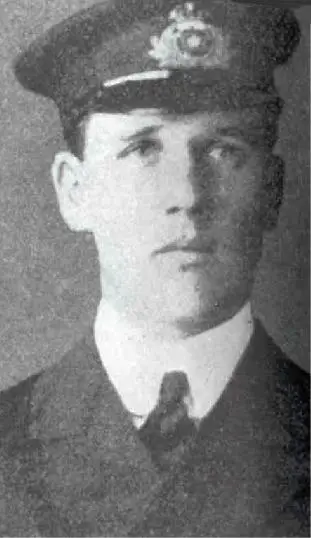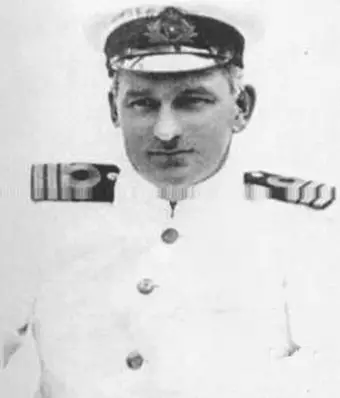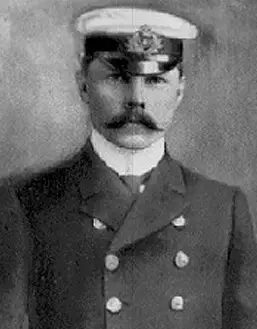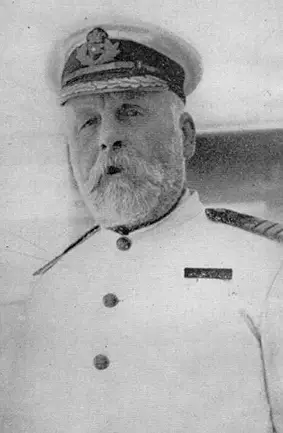Side Menu:
Fourth Officer Joseph Boxhall
- Final Watches

Sixth officer Moody's duty was to log the sea
temperature, according to Boxhall.
4pm - 6pm: Temperature drop
As Titanic continued on her southern track towards New York as planned, Boxhall was aware that the sea temperature was being tested and reported in the log by the junior officer, athough he personally felt there was no connection between sea temperature and the proximity of icebergs. "The sailor men and the quartermaster took this temperature, and I would see them doing it, sometimes." he said at the US Inquiry:
"It was reported to the junior officer... Mr. Moody... it was the junior officer’s duty to see that the log did contain it. " Later he said "I have had quite a lot of experience in field ice and to the best of my knowledge I do not think the temperature indicates anything. I do not think that is anything to go by…I have made observations, years ago; but on the Titanic the sixth officer or the fifth officer had to note all those observations, and that is why I did not know the temperatures recorded." (US Inquiry).
During his Sunday 4 - 6pm watch he had noted that the temperature had been falling: "I happened to remark that it was rather cold, and somebody said, "It is 31"; but I do not know what time it was. I think it was during my watch from 4 to 6 Sunday evening… I had only gone on deck at 4 o'clock. I went on deck at 4 Sunday afternoon and was on deck until 6, and I knew it was colder than it was at noon, when I left the bridge."
The Corner at 5.50pm

Boxhall spoke to Chief Officer Wilde regarding 'turning the corner.'
Another important moment during Boxhall's 4 - 6pm watch was calculating the course and the point where Titanic turned the 'corner' -turning the ship further south, pointing her towards New York - which Boxhall states happened at 5.50pm. At the British inquiry he stated: "The course was altered at 5.50... I do not remember the compass course, but I remember the true course was S. 86 W... I had stellar observations afterwards." (British Inquiry).
Chief Officer Wilde, who was officer of the watch between 2pm and 6pm, spoke to Boxhall about this and Boxhall believed they had run beyond the "corner": "The night order book was written out and there was an order for the course to be altered at 5.50… I saw it and I remarked to the Chief Officer between 4 o’clock and 6 o’clock that I considered the course ought to have been altered some considerable time before 5.50 - that is, if it was meant to be altered at the corner, 42 N., 47 W. Whether we spoke to the Captain about it or not I do not know. I just remarked that to the Chief Officer, and the course was altered at 5.50. I consider that the ship was away to the southward and to the westward of that 42 N. 47 W. position when the course was altered. (British Inquiry)
At the British Inquiry he was handed a chart which had the corner marked as " 42 N. 47 W." and Boxhall was asked to mark the position. Boxhall believed Titanic had run beyond the corner and was "to the south and to the westward of it" and her new course now "S. 86. W… I think it is about S. 84 3/4 W. as a matter of fact." (British Inquiry)
The difference was notable enough for Boxhall to raise it with Chief Officer Wilde: " I do not remember what time it was but it was some considerable time; the difference I make between my time and the time that was given in the book - well there was such a big difference that I considered it worth mentioning to the Senior Officer of the watch." (British Inquiry)
8pm - 12am: Final watch

Third officer Pitman passed on his
calculations to Boxhall saying "Here is a
bunch of sights for you, old man.
Go ahead."
Third officer Pitman finished his watch at 8pm and handed over his calculations to Boxhall. Pitman explains he was " working out the observations… In the chart room; in the chart house… I was there alone until 8 o'clock… I did not finish them. Mr. Boxhall took on then and finished them… .I simply said "Here is a bunch of sights for you, old man. Go ahead." (US Inquiry) Although Pitman "cannot remember it exactly" he thinks that the officers discussed the possibility of ice on the "Sunday. It might have been about 8 o'clock. I do not remember the time... we were just remarking that we should be in the vicinity of ice in Mr. Murdoch’s watch... I cannot remember now, sir, when it occurred, and I have not now the slightest idea who was there... I just heard the remark passed; that was all." (US Inquiry)
In his 1962 interview Boxhall described it this way: "I went on watch at 8 o'clock, on that Sunday night the 14th of April, along with Moody who was the Sixth Officer, and we went on the bridge with Mr. Murdoch the First Officer. It was a clear night there were no signs of any fog. The set of stars was handed over to me that Lightoller had taken in the Second Dog Watch. When I got these stars I said, 'Now Moody you go around the decks and come back at nine o'clock.'" (BBC radio interview October 1962)
For this four hour shift, Boxhall said "most of the time I was on the bridge... I was in the chart room working out positions, most of the evening - working navigation." (British Inquiry) But then starting his watch Boxhall did not check the chart." I did not look at the chart when I came on at 8 o’clock." (British Inquiry). He also mentioned in 1962 that after he and Moody arrived on watch together he instructed Moody to go on his rounds and be back by 9.00 pm.
Boxhall was aware of the calculation of the ship's position at 7.30pm, before his watch had started and he used it to help calculate their stellar position. "I do not remember looking at the Captain’s position on the chart. I was standing by the door when he put it on. I could see my work on the chart in the distance, but I do not remember examining the thing closely... I had the 7.30 position in my work book... I had used that same position two or three times after giving it to the Captain, and that same course I used two or three times after giving it to the Captain as well, between 10 o’clock and the time of the collision, for the purpose of working up stellar deviations… checking the compass error." (British Inquiry)
According to Boxhall, he did not know they were approaching any icebergs and there was never a discussion of ice with Captain Smith or First officer Murdoch. "I did not know we were in the vicinity of icebergs... I knew we had had information. They [Smith and Murdoch] did not apprise me that evening of it… As a matter of fact they did not mention it to me." (US Inquiry)
Captain Smith

Boxhall said he saw Captain Smith "frequently
during the watch"
Boxhall saw Captain Smith a number of times during his watch. "I saw him frequently during the watch… Up to the time of the accident… On and off, most of the watch. Sometimes out on the outer bridge. I would go out and report. I was working observations out, if you understand, most of that watch working out different calculations and reporting to him; and that is how it was I came in contact with him so much… Sometimes in his chart room and sometimes on the bridge, and sometimes he would come to the wheelhouse, inside of the wheelhouse… I would see him pass through [the wheelhouse].(US Inquiry)
Boxhall remembers reporting positions to Captain Smith at about 9pm but cannot recall the location: "About 9 o'clock… I do not remember whether I saw him on the bridge or in the wheelhouse when I reported some positions that I had worked out…. I did not know that the captain was anywhere away from the bridge the whole watch. I mean to say from the bridge taking the whole bridge together; all the chart rooms, and the open bridge. They are all practically on one square, and I do not think the captain was away from that altogether." (US Inquiry)
At the British Inquiry Boxhall also recalls talking to Captain Smith from 9pm: The first that I remember seeing of Captain Smith was somewhere in the vicinity of 9 o’clock, but from 9 o’clock to the time of the collision, Captain Smith was around there the whole of the time; I was talking to him on one or two occasions. … Sometimes in the officers’ chart room and sometimes at his chart room door… I was discussing some stellar bearings I had had. I was also standing at his chart room door while he pricked off the 7.30 stellar position of the ship... the Captain pricked the position…It would be pretty nearly 10 o’clock, I should think. " (British Inquiry)
10pm star position
Explaining the process of taking star positions to calculate the ship's positions, Boxhall said:
"The officer who takes the observations always is the senior officer… He simply takes the observations with his sextant. The junior officer takes the time with the chronometer, and then is told to work them out… When you take stars you always endeavor, as they did that night, to take a set of stars. One position checks another. You take two stars for latitude, and two for longitude, one star north and one star south, one star east and one star west. If you find a big difference between eastern and western stars, you know there is a mistake somewhere. If there is a difference between these two latitude stars you know there is a mistake somewhere. But, as it happened, I think I worked out three stars for latitude and I think I worked out three stars for longitude…. They all agreed…. I was working these things out after 8 o'clock, and Mr. Lightoller took them before 8 o'clock….I finished before 10 o'clock, because I gave Mr. Lightoller [sic] the results when I finished… After I had worked these observations of Mr. Lightoller's I was taking star bearings for compass error for myself, and was working those out. That is what kept me in the chart room most of the time. I was making computations most of the time. (US Inquiry)
As Boxhall spent most of his time "inside the chart room working up stellar observations from 8 o’clock." He remembers the Captain putting down a star position at 10pm:
"Well, as near as I can remember I went to the chart room with the Captain, but the Captain put down the star position when I gave it him, somewhere about 10 o’clock. He put the position on, and I was standing close to him, but I did not take that much notice whether any other positions were put on or not… we had three stars for latitude, and I think three or four for longitude." (British Inquiry)
He spoke of this later in 1962:
"I don't know whether the Captain came up before nine o'clock or after nine o'clock, but anyway, I didn't leave the bridge until after ten o'clock. Having worked the stars out and when the Captain came up I showed him the position on the chart she was just over twenty miles ahead of her Dead Reckoning."(BBC interview October 1962)
Boxhall's Conclusion of Positions/Ice Warnings:
In summary, Boxhall while aware of ice positions ahead did not think any were on their track. "From all the positions of icebergs that I had, of course I knew that we should be getting close up to those positions in the early hours of the middle watch; at least. I did not think we should be up to any of those positions before midnight that night... But these bergs I did not put down in positions that were south of the track, or else I should have made a special note to the captain about them. If I had seen any on the track or the southward of the track I should have done that." (US Inquiry)
In the British Inquiry he confirmed the belief that all icebergs were on the northern track: "All the ice I remember plotting out was to the northward of the track. If it had been on the track or to the southward I should have seen fit then to call the Captain’s special attention to it at the time I put it on. But I just merely remarked to him that I had put down the ice we had had reported; whenever I did put it on the chart, I remarked to him that I had done so. But if it had been so close to the track as that I should have thought it an immediate danger to the ship. I should have pointed it out specially to him, and I never had reason to do that."
During the British Inquiry, when the message from the Mesaba was raised, Boxhall was adamant that he did not know anything about it. He stated that if he had seen he "would have taken it to the senior officer of the watch, and let him open it. Very often on dark nights they tell us to take them inside, and we open them inside and tell them the contents of the message."
After 10pm Boxhall, having shown Captain Smith the ship's position on the chart, left the bridge: "And at ten o'clock I told Moody to take over the bridge and I reported to the First Officer that I was going around the decks, it was the customary thing." (BBC interview October 1962). Second officer Lightoller called this process of going around the decks as “going round” (British Inquiry) spending possibly 30 minutes checking out corridors, ladders, and stairwells, looking for anything which might be amiss.
Where was Boxhall before the collision?
Until 1959 and later in 1962, the issue of where Boxhall was in the moments prior to the collision at 11.40pm was largely unknown. At the US and UK inquiries he only mentioned that he was on his way towards the bridge. He stated that he heard the three bells from the lookout as he was "just coming out of the officers quarters." (British Inquiry) and the collision occurred as Boxhall was "just approaching the bridge…Starboard side... I was just coming along the deck and almost abreast of the captain's quarters" (US Inquiry)
However this begged the question, that was apparently never asked at either inquiry: where was he coming from? What was he doing? His watch was about to finish in 20 minutes time at midnight. He had gone on his 'round' shortly after 10pm. The 'rounds' would likely take no more than half an hour to an hour. Even if they took an hour there is still a 30 minute gap in his story that had no explanation.
That was until 1959 when an article appeared in the May 1959 edition of the Nautical Magazine in which Boxhall explained, during a talk at the Christchurch Red House Museum, that he "had just looked into his cabin when he heard the lookout sound three bells":
"He had done a tour of the decks and had just looked into his cabin when he heard the lookout sound three bells. He immediately went out on deck again, and a few minutes later, at about 10.40 p.m., when the ship struck, he felt no more than a slight tremor.("A Talk by the Fourth Officer of the Titanic", by William Sandrey, May 1959 The Nautical Magazine, pages 262 - 264)
Later in 1962 he even went further to describe what he was doing in his cabin, when in his BBC radio interview he explained:
"At the time when the iceberg was reported from the Crow's Nest, when they struck the bells... I was sitting in my cabin having a cup of tea, and immediately got up … And walked along to the bridge about sixty feet away on the same deck. I was about half way between the Officer's Quarters, the entrance of the Officer's Quarters and the Bridge when the crash came" (BBC interview October 1962)
This was a surprise acknowledgement on behalf of Boxhall - that he was "sitting in his cabin having a cup of tea" as he was supposed to be on duty at the time and so he could be accused of a dereliction of duty.

A 3D model of Fourth officer Boxhall's cabin. According to Boxhall's later revelations, this is where he was just prior to the iceberg collision, despite being on duty. (3D image: Yannick Allen-Larochelle)
It also contradicts what he said at the British Inquiry in 1912 where he had stated under oath that "most of the time I was on the bridge……I was in the chart room working out positions, most of the evening - working navigation." (British Inquiry). If he had left the bridge shortly after 10pm, and had not returned by 11.40, then he had spent nearly half of the four hour shift away from the bridge.
To explain the contradiction, a range of possible theories have been suggested:
1. He was suffering from a cold and so had been given special dispensation by Murdoch (Officer of the Watch) to drink tea in his cabin (it is known Boxhall became ill with pleurisy shortly afterward)
2. He was in the lavatory and too ashamed to admit this publicly
3. He was on the compass platform with QM Olliver
In the same 1962 account he mentions Sixth officer Moody aboard the Carpathia (when actually Moody perished in the disaster) so it is possible that his memory about drinking tea in his cabin is faulty, as he was 78 years old at the time of the broadcast.